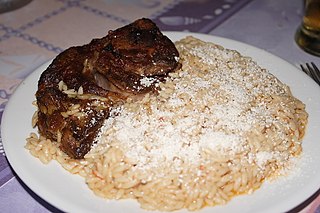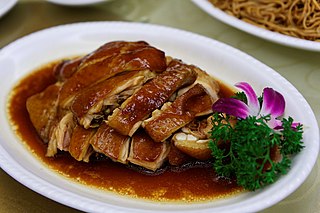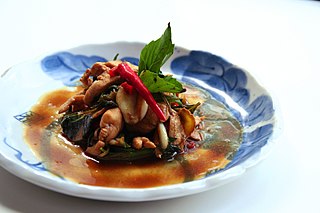
Greek cuisine is the cuisine of Greece and the Greek diaspora. In common with many other cuisines of the Mediterranean, it is founded on the triad of wheat, olive oil, and wine. It uses vegetables, olive oil, grains, fish, and meat, including pork, poultry, veal and beef, lamb, rabbit, and goat. Other important ingredients include pasta, cheeses, lemon juice, herbs, olives and olive oil, and yogurt. Bread made of wheat is ubiquitous; other grains, notably barley, are also used, especially for paximathia. Common dessert ingredients include nuts, honey, fruits, sesame, and filo pastries. It continues traditions from Ancient Greek and Byzantine cuisine, while incorporating Turkish, Balkan, and Italian influences.

Lasagna is a type of pasta, possibly one of the oldest types, made of very wide, flat sheets. Either term can refer to an Italian dish made of stacked layers of lasagna alternating with fillings such as ragù, béchamel sauce, vegetables, cheeses, and seasonings and spices. The dish may be topped with grated cheese, which becomes melted during baking. Typically cooked pasta is assembled with the other ingredients and then baked in an oven. The resulting baked pasta is cut into single-serving square or rectangular portions.

Butter chicken, traditionally known as murgh makhani, is an Indian dish originating in Delhi. It is a type of curry made from chicken with a spiced tomato and butter (makhan) sauce. Its sauce is known for its rich texture. It is similar to chicken tikka masala, which uses a tomato paste.

Avgolemono is a family of sauces and soups made with egg yolk and lemon juice mixed with broth, heated until they thicken.

Tsukune (つくね、捏、捏ね) is a Japanese chicken meatball most often cooked yakitori style and sometimes covered in a sweet soy or yakitori tare, which is often mistaken for teriyaki sauce.

Comfort food is food that provides a nostalgic or sentimental value to someone and may be characterized by its high caloric nature associated with childhood or home cooking. The nostalgia may be specific to an individual or it may apply to a specific culture.

Soy sauce chicken is a traditional Cantonese cuisine dish made of chicken cooked with soy sauce. It is considered as a siu mei dish in Hong Kong.

Sanbeiji is a popular chicken dish in Chinese cuisine and one of the most iconic dishes of Jiangxi cuisine. The dish originates from the Jiangxi province of southern China, and is a specialty of Ningdu where the population are Hakka. The dish has become especially popular in Taiwan, being introduced to the island by the Hakka people. It is also served as a postpartum confinement food by the Chinese community of Malaysia. The Jiangxi style has a complex flavor and is spicy, while the Taiwan variant has a more simplistic flavor and is non-spicy.

Kofta is a family of meatball or meatloaf dishes found in South Asian, Central Asian, Balkan, Middle Eastern, North African, and South Caucasian cuisines. In the simplest form, koftas consist of balls of minced meat – usually beef, chicken, pork, lamb or mutton, or a mixture – mixed with spices and sometimes other ingredients. The earliest known recipes are found in early Arab cookbooks and call for ground lamb.

Spaghetti and meatballs is an Italian-American pasta dish consisting of spaghetti, tomato sauce and meatballs.

Bakmi or bami is a type of wheat based noodles derived from Chinese cooking tradition. It was brought to Indonesia by Chinese immigrants from Southern Chinese provinces like Fujian. It is typically prepared seasoned in soy sauce and topped with pork products, which is often substituted for other protein sources in predominantly Muslim Indonesia. Chinese-style wheat noodles has become one of the most common noodle dishes, especially in Southeast Asian countries which have significant Chinese populations and known by various names.

Mie goreng, also known as bakmi goreng, is an Indonesian stir-fried noodle dish. It is made with thin yellow noodles stir-fried in cooking oil with garlic, onion or shallots, fried prawn, chicken, beef, or sliced bakso (meatballs), chili, Chinese cabbage, cabbages, tomatoes, egg, and other vegetables. Ubiquitous in Indonesia, it is sold by food vendors from street hawkers (warungs) to high-end restaurants.

Afghan cuisine is influenced to a certain extent by Persian, Central Asian and Indian cuisines due to Afghanistan's close proximity and cultural ties. The cuisine is halal and mainly based on mutton, beef, poultry and fish with rice and Afghan bread. Accompanying these are common vegetables and dairy products, such as milk, yogurt, and whey, and fresh and dried fruits such as apples, apricots, grapes, bananas, oranges, plums, pomegranates, sweet melons, and raisins. The diet of most Afghans revolves around rice-based dishes, while various forms of naan are consumed with most meals. Tea is generally consumed daily in large quantities, and is a major part of hospitality. The culinary specialties reflect the nation's ethnic and geographic diversity. The national dish of Afghanistan is Kabuli palaw, a rice dish cooked with raisins, carrots, nuts, and lamb or beef.

Chicken parmesan or chicken parmigiana is a dish that consists of breaded chicken breast covered in tomato sauce and mozzarella, Parmesan, or provolone. A quantity of ham or bacon is sometimes added.

A meatball is ground meat (mince) rolled into a ball, sometimes along with other ingredients, such as bread crumbs, minced onion, eggs, butter, and seasoning. Meatballs are cooked by frying, baking, steaming, or braising in sauce. There are many types of meatballs using different types of meats and spices. The term is sometimes extended to meatless versions based on vegetables or fish; the latter are also commonly known as fish balls.

Bang bang chicken, also known by variant names such as bam bam chicken or bon bon chicken, is a popular chicken dish in Chinese cuisine. The name bang bang chicken is derived from the Chinese word for stick, bàng (棒), referring to the baton or cudgel traditionally used to tenderize the meat.

Indonesian noodles are a significant aspect of Indonesian cuisine which is itself very diverse. Indonesian cuisine recognizes many types of noodles, with each region of the country often developing its own distinct recipes.

Curry, a spicy South Asian-derived dish, is a popular meal in the United Kingdom. Curry recipes have been printed in Britain since 1747, when Hannah Glasse gave a recipe for a chicken curry. In the 19th century, many more recipes appeared in the popular cookbooks of the time. Curries in Britain are widely described using Indian terms, such as korma for a mild sauce with almond and coconut, Madras for a hot, slightly sour sauce, and pasanda for a mild sauce with cream and coconut milk. One type of curry, chicken tikka masala has become widespread enough to be described as the national dish of the United Kingdom.


















